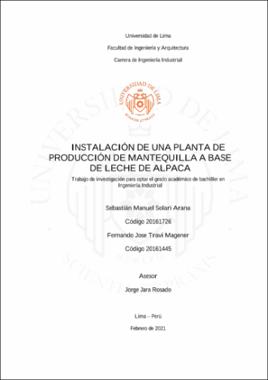Instalación de una planta de producción de mantequilla a base de leche de alpaca
Abstract
El presente trabajo de investigación busca analizar la viabilidad técnica, comercial,
financiera y social de instalar una planta productora de mantequilla a base de leche de
alpaca. Para esto, en primer lugar, se analiza el mercado, con el fin de determinar la
demanda potencial que será el primer paso para observar si el producto puede ser
fabricado industrialmente. Para lo cual se considera los posibles patrones de consumo, el
público objetivo y su crecimiento, así como el uso de encuestas para determinar la
intensidad, la frecuencia y la intención de compra.
En segundo lugar, se analizará la localización óptima de la planta, considerando
distintos factores, entre ellos: la disponibilidad de materia prima, la cercanía al mercado
y la capacidad de la mano de obra. Esto se desarrollará sin antes haber analizado que
aspecto es el que determina finalmente el tamaño de la planta a instalar.
En tercer lugar, se evaluará la ingeniería del proyecto, considerando el proceso de
producción necesario, la tecnología y maquinaria requerida y la determinación del cuello
de botella en base a los tiempos que toma cada proceso. Una vez finalizado este análisis,
se podrá realizar la disposición de planta, obteniendo un plano general.
Posteriormente, se desarrollará una investigación acerca de la inversión requerida,
considerando que se necesitará adquirir la infraestructura de la planta, así como la
maquinaria y equipos y demás materiales. Una vez obtenido el costo de la inversión y
considerando tanto la demanda para proyectar las futuras ventas como los distintos costos
mensuales futuros, se podrá observar si efectivamente el proyecto es financiera y
económicamente viable. Por último, se analizará el impacto social de elaborar una planta
como la descrita. This research work seeks to analyze the technical, commercial, financial, and social
feasibility of installing a butter-producing plant based on alpaca milk. For this, first, the
market is analyzed to determine the potential demand, which will be the first step to see
if the product can be manufactured industrially. For which the possible consumption
patterns, the target audience, and its growth are considered, as well as the use of surveys
to determine the intensity, frequency, and purchase intention.
Second, the optimal location of the plant will be analyzed, considering different
factors, among them: the availability of raw material, proximity to the market, and the
capacity of the workforce. This will be done without first having analyzed which aspect
is the one that finally determines the size of the plant to be installed.
Third, the engineering of the project will be evaluated, considering the necessary
production process, the technology and machinery required, and the determination of the
bottleneck based on the times each process takes. Once this analysis is finished, the floor
plan can be made, obtaining a general plan.
Subsequently, an investigation will be carried out on the required investment,
considering that it will be necessary to acquire the plant infrastructure, as well as the
machinery and equipment and other materials. Once the cost of the investment has been
obtained and considering both the demand to project future sales and the different future
monthly costs, it will be possible to see if the project is financially and economically
viable. Finally, the social impact of making a plant like the one described will be
analyzed.
How to cite
Solari Arana, S. M. y Travi Magener, F. J. (2021). Instalación de una planta de producción de mantequilla a base de leche de alpaca [Trabajo de Investigación para optar el grado de Bachiller en Ingeniería Industrial, Universidad de Lima]. Repositorio Institucional de la Universidad de Lima. https://hdl.handle.net/20.500.12724/13752Publisher
Universidad de LimaSubject
Work type
Trabajo de investigaciónCollections
The following license files are associated with this item:


